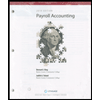
Fundamentals Of Financial Accounting
6th Edition
ISBN: 9781259864230
Author: PHILLIPS, Fred, Libby, Robert, Patricia A.
Publisher: Mcgraw-hill Education,
expand_more
expand_more
format_list_bulleted
Textbook Question
Chapter 1, Problem 4PA
Evaluating Financial Statements
Refer to PA1-3.
Required:
- 1. Did Nice Bite rely more on creditors or stockholders for its financing at December 31, 2016? What is your information source?
- 2. Did the
retained earnings at December 31, 2016, arise primarily from current year earnings or earnings retained from prior years? What is your information source?
Expert Solution & Answer
Want to see the full answer?
Check out a sample textbook solution
Students have asked these similar questions
Need correct answer general Accounting
What is the total acquisition cost of the land on these financial accounting question?
Get correct solution this financial accounting question
Chapter 1 Solutions
Fundamentals Of Financial Accounting
Ch. 1 - Define accounting.Ch. 1 - Prob. 2QCh. 1 - Briefly distinguish financial accounting from...Ch. 1 - The accounting process generates financial reports...Ch. 1 - Explain what the separate entity assumption means...Ch. 1 - List the three main types of business activities...Ch. 1 - What information should be included in the heading...Ch. 1 - What are the purposes of (a) the balance sheet,...Ch. 1 - Explain why the income statement, statement of...Ch. 1 - Briefly explain the difference between net income...
Ch. 1 - Describe the basic accounting equation that...Ch. 1 - Describe the equation that provides the structure...Ch. 1 - Describe the equation that provides the structure...Ch. 1 - Prob. 14QCh. 1 - Prob. 15QCh. 1 - Prob. 16QCh. 1 - Briefly define what an ethical dilemma is and...Ch. 1 - Prob. 18QCh. 1 - Prob. 1MCCh. 1 - Which of the following is true regarding the...Ch. 1 - Which of the following is false regarding the...Ch. 1 - Which of the following regarding retained earnings...Ch. 1 - Prob. 5MCCh. 1 - Which of the following statements regarding the...Ch. 1 - Prob. 7MCCh. 1 - Which of the following is true? a. FASB creates...Ch. 1 - Which of the following would not be a goal of...Ch. 1 - Prob. 10MCCh. 1 - Prob. 1MECh. 1 - Matching Definitions with Terms or Abbreviations...Ch. 1 - Matching Definitions with Terms Match each...Ch. 1 - Matching Financial Statement Items to Balance...Ch. 1 - Matching Financial Statement Items to Balance...Ch. 1 - Matching Financial Statement Items to Balance...Ch. 1 - Matching Financial Statement Items to Balance...Ch. 1 - Matching Financial Statement Items to the Basic...Ch. 1 - Matching Financial Statement Items to the Four...Ch. 1 - Reporting Amounts on the Statement of Cash Flows...Ch. 1 - Prob. 11MECh. 1 - Preparing a Statement of Retained Earnings Stone...Ch. 1 - Relationships among Financial Statements Items...Ch. 1 - Prob. 14MECh. 1 - Relationships among Financial Statements Items...Ch. 1 - Preparing an Income Statement, Statement of...Ch. 1 - Reporting Amounts on the Four Basic Financial...Ch. 1 - Reporting Amounts on the Four Basic Financial...Ch. 1 - Preparing a Balance Sheet DSW, Inc., is a designer...Ch. 1 - Completing a Balance Sheet and Inferring Net...Ch. 1 - Labeling and Classifying Business Transactions The...Ch. 1 - Preparing an Income Statement and Inferring...Ch. 1 - Preparing an Income Statement Home Realty,...Ch. 1 - Prob. 8ECh. 1 - Preparing an Income Statement and Balance Sheet...Ch. 1 - Analyzing and Interpreting an Income Statement...Ch. 1 - Prob. 11ECh. 1 - Matching Cash Flow Statement Items to Business...Ch. 1 - Preparing an Income Statement. Statement of...Ch. 1 - Interpreting the Financial Statements Refer to...Ch. 1 - Reporting Amounts on the Four Basic Financial...Ch. 1 - Evaluating Financial Statements Refer to CP1-3....Ch. 1 - Preparing an Income Statement, Statement of...Ch. 1 - Prob. 2PACh. 1 - Reporting Amounts on the Four Basic Financial...Ch. 1 - Evaluating Financial Statements Refer to PA1-3....Ch. 1 - Preparing an Income Statement and Balance Sheet...Ch. 1 - Interpreting the Financial Statements Refer to PB...Ch. 1 - Reporting Amounts on the Four Basic Financial...Ch. 1 - Evaluating Financial Statements Refer to PB1-3....Ch. 1 - Finding Financial Information Answer the following...Ch. 1 - Comparing Financial Information Refer to the...Ch. 1 - Prob. 5SDCCh. 1 - Prob. 6SDCCh. 1 - Prob. 1CC
Knowledge Booster
Learn more about
Need a deep-dive on the concept behind this application? Look no further. Learn more about this topic, accounting and related others by exploring similar questions and additional content below.Similar questions
arrow_back_ios
SEE MORE QUESTIONS
arrow_forward_ios
Recommended textbooks for you
 Financial Accounting: The Impact on Decision Make...AccountingISBN:9781305654174Author:Gary A. Porter, Curtis L. NortonPublisher:Cengage LearningPrinciples of Accounting Volume 1AccountingISBN:9781947172685Author:OpenStaxPublisher:OpenStax College
Financial Accounting: The Impact on Decision Make...AccountingISBN:9781305654174Author:Gary A. Porter, Curtis L. NortonPublisher:Cengage LearningPrinciples of Accounting Volume 1AccountingISBN:9781947172685Author:OpenStaxPublisher:OpenStax College

Financial Accounting: The Impact on Decision Make...
Accounting
ISBN:9781305654174
Author:Gary A. Porter, Curtis L. Norton
Publisher:Cengage Learning

Principles of Accounting Volume 1
Accounting
ISBN:9781947172685
Author:OpenStax
Publisher:OpenStax College


Financial ratio analysis; Author: The Finance Storyteller;https://www.youtube.com/watch?v=MTq7HuvoGck;License: Standard Youtube License